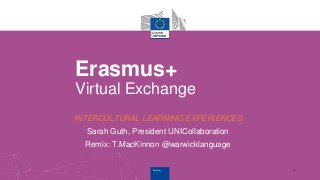OBF Academy - Case Erasmus+ Virtual Exchange
Using Open Badges for recognition of participation in Virtual Exchange: the Erasmus Plus Experience, Virtual Exchange experience. Teresa MacKinnon, Associate Professor from University of Warwick, UK, will present a case study drawn from the experiences of using Open Badge Factory to create an ecosystem of badges for virtual exchange. Virtual exchange is technology-enabled people-to-people dialogues sustained over a period of time. It: * uses new media platforms to enable deep, interactive social learning * was developed over 30 years from experience in the field of educational exchange and study abroad * makes it possible for every young person to have meaningful, transnational and intercultural experiences * prepares, deepens, and extends physical exchanges This European Commission initiative brings together multiple partners to expand the reach and scope of the Erasmus+ programme, engaging at least 17,000 young people. It provides an accessible, innovative way for young people in Europe and the Southern Mediterranean to engage in meaningful intercultural experiences online, as part of their formal or non-formal education. Open Badges are used to promote visibility and recognition of the engagement in Virtual Exchange opportunities we offer. The digital nature of this form of recognition reflects and enhances the digital skills acquired through this initiative.

Recommended
Recommended
More Related Content
More from Open Badge Factory Ltd.
More from Open Badge Factory Ltd. (20)
Recently uploaded
Recently uploaded (20)
OBF Academy - Case Erasmus+ Virtual Exchange
- 1. Erasmus+Erasmus+ Erasmus+ Virtual Exchange INTERCULTURAL LEARNING EXPERIENCES Sarah Guth, President UNICollaboration Remix: T.MacKinnon @warwicklanguage 1
- 2. Erasmus+ What is Virtual Exchange? “Technology-enabled people-to-people dialogues sustained over a period of time”. ● Use of new media platforms to enable deep, interactive social learning ● Developed over 30 years from experience in the field of educational exchange and study abroad ● Making it possible for every young person to have meaningful, transnational and intercultural experiences. ● Prepares, deepens, and extends physical exchanges, and fuels new demand for physical exchange. 2
- 3. Erasmus+ What is Erasmus+ Virtual Exchange? ● Erasmus+ Virtual Exchange is a groundbreaking pilot project established by the European Commission in 2018. ● Erasmus+ Virtual Exchange aims to expand the reach and scope of the Erasmus+ programme through virtual exchanges by engaging at least 17,000 youth by the end of 2019. ● This project will complement the traditional physical mobility programme. ● An accessible, innovative way for young people in Europe and the Southern Mediterranean to engage in meaningful intercultural experiences online, as part of their formal or non-formal education. 3
- 4. Erasmus+ Target Audiences Open to any young person aged 18-30 residing in Erasmus+ programme countries and the Southern Mediterranean. ● Young people (aged 18 to 30 years) ● Youth workers ● Students ● Higher education professors ● University managers/administrators ● Educators https://europa.eu/youth/erasmusvirtual/who-can-take-part_en 4
- 6. Erasmus+ 6 The professors and their support teams work together to develop: ● shared learning outcomes ● a syllabus for this new international component With a focus on the development of activities that promote: ● interaction ● collaboration between students
- 7. Erasmus+ 7 ● The courses are usually blended ● They last 4-10 weeks ● They have at least 1 synchronous video session ● They can be implemented in any subject or course
- 9. Erasmus+ 9
- 11. Erasmus+ Recognition 11 Next steps: • EU visual identity work under way • A more unified programme identity • Capacity building for creation and delivery of new VEs • Increase connections with other organisations with similar aims
- 12. Erasmus+ Roadmap Achieved • Proof of concept: open badges use has been well received on the whole. • Badges issued to date: 4,366 To do • Upgrading account to increase capacity and improve reporting • Visual identity of badges and eco-sytem to be developed further • Increase awareness of this form of recognition and how earners can manage their awards. 12
